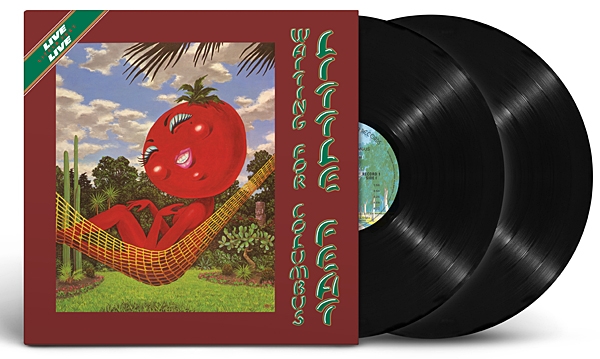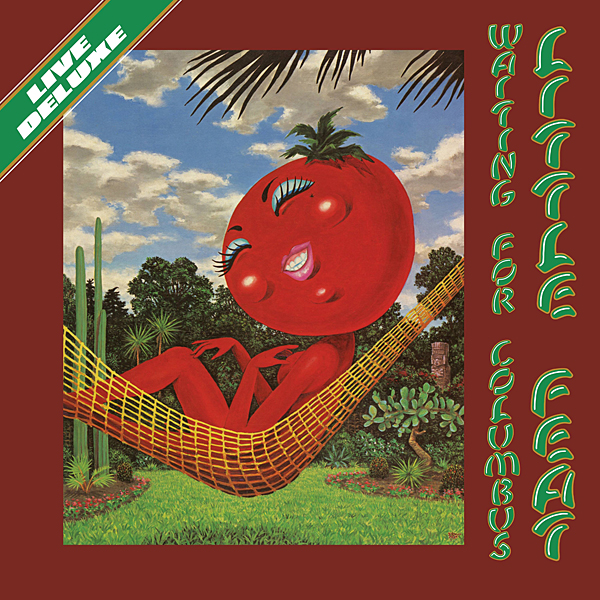| Columns Retired Columns & Blogs |
Unfortunate reference to a speedball hit...

There's a lot of tape in the vault, some of it very fine, indeed.
Little Feat released six studio albums and one live album before George died, all on the Warner Bros. label. For the first two, the band was a quartet, two members of which—bassist Roy Estrada and guitarist Lowell George—served time with Frank Zappa. (Estrada, sadly, is serving actual time: 25 years without parole in Texas, after pleading guilty to repeated, heinous crimes.) For their third album, 1973's
Dixie Chicken (Warner Bros. BS 2686), the group welcomed Kenny Gradney on bass and Sam Clayton on congas; those two joined Paul Barrere on second guitar and original members George, Richie Hayward (drums), and Bill Payne (keyboards). All contributed to the songwriting, with George as the principal writer.
Released in 1978 as a double LP, Waiting for Columbus (Warner Bros. 2BS 3140) is Little Feat's great live album and one of the great live albums in rock'n'roll history. It's the only Little Feat album to go platinum, and Rolling Stone tagged it 7th on their top-500 live-albums list. I think it's one of the two best-sounding live rock recordings ever; the other is the Grateful Dead's Live Dead (Warner Bros. 2WS 1830).
Now the Gringotts goblins at Warner Bros. have rummaged around the vault and brought forth a monster-sized prize. Waiting for Columbus Live Deluxe (Rhino R2 680966) contains more than 7 hours of music in an 8-CD boxed set. The first two discs contain the original album, newly remastered. The other six discs hold three complete shows, two from England and one from Washington, DC; two of the three served as sources for the original live album. The Deluxe set is also available streaming, at 24/96. It was mastered by Bill Inglot and Dan Hersch.
Also available—and the reason for putting this in Revinylization—is a standalone, 180gm remastering of the original 2-LP release (Warner Records R1 3140), cut by Bernie Grundman and pressed at Precision Record Pressing in Canada, which says it's the only pressing plant that uses all-new—nonvintage—machines.

With quality and mastering-chain issues on my mind, I spoke with mastering wizard Bernie Grundman to get the skinny about the new vinyl. Bernie told me he cut the lacquers for the new LPs from "a ¼", 30ips original master tape in very good condition." Grundman can often tell if a tape is first generation or not by the number of tape splices: If there aren't many, it's probably a copy; original studio masters tend to have more edits. He continued: "Quarter-inch tape is the best format for a stereo master, better than half-inch tape. The impedance curve is better. This has to do with the size of the playback head and how the signal behaves. But ½" tape is more durable and 3dB quieter, with less tape hiss, than ¼" tape."
The Grateful Dead got lucky with Live Dead, gaining access to one of the first 16-track Ampex tape decks. By the time Little Feat planned their live album, tech had evolved to include 24-track decks and high-quality mixing consoles in remote trucks. The shows recorded at London's Rainbow Theatre in August 1977 employed the Manor Mobile Unit, Richard Branson's truck. Manning the console was none other than George Massenburg, who had already spent quality time with the group in Baltimore recording Feats Don't Fail Me Now (Warner Bros. BS 2784). A similarly excellent live recording was made a week later at George Washington University's Lisner Auditorium; Warren Dewey is credited with engineering that one.
Live, yes, but significant elements were added and subtracted during extensive overdub sessions in L.A. Lowell George, who is credited as producer, learned his perfectionism at the knee of Uncle Frank. He is known to have driven himself and those around him hard in the studio.
The resulting music is as good as it gets.
This is not '70s yacht rock. When the group brought in Kenny Gradney and Sam Clayton, they injected a speedball hit of New Orleans into a rhythm section that was already tight and funky. It's all about finding the pocket—the right tempo for a song or groove. Lowell often told the band to slow it down until it clicked; it's what Donald Fagen, in his own music of the time, called "junkie grooves." Though the Feat share elements with other '70s funk-based bands, there's something here a little looser, more syncopated, hipper than in the music of their peers, the musicians playing slightly ahead or slightly behind the beat: Just listen to "Mercenary Territory" followed by "Spanish Moon." Add Lowell's soulful vocals and best-of-show spark-puller slide guitar work and the Tower of Power horns and you have the makings of a killer performing unit.
And don't forget the strong, unique songwriting by George and the other members of the band.
As John Atkinson put it to me recently, paraphrasing a lyric from "Rock and Roll Doctor," "If you like the sound of shufflin' feet, (Little Feat) can't be beat!"

Unfortunate reference to a speedball hit...

Lowell George was no angel, though he could sing like one. Does this mean "China White" is an unfortunate song? Hoy Hoy.

This finally confirms there were more fans of Little Feat in the UK than USA. For us UK fans the albums were hard to get into because of the cultural differences but the musicianship etc was undeniable. Waiting For Columbus summed up their early career, much better than a greatest hits album, and flowed beautifully.